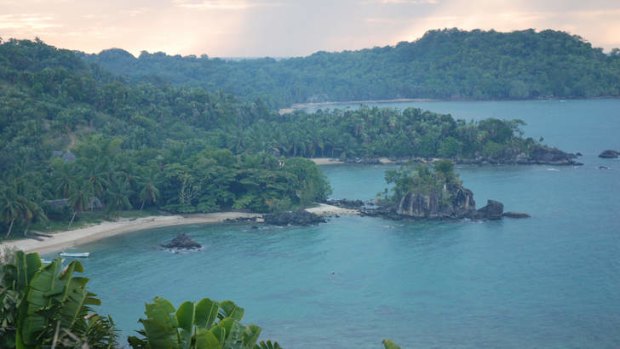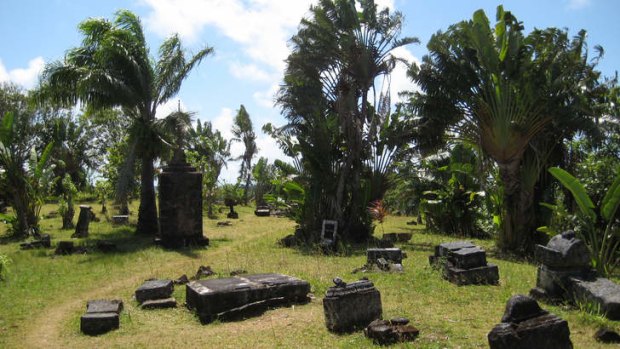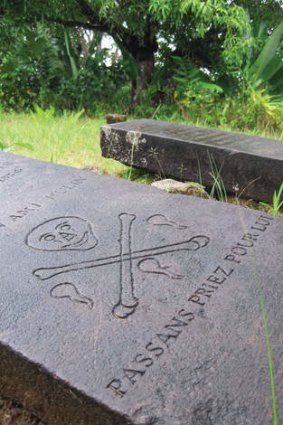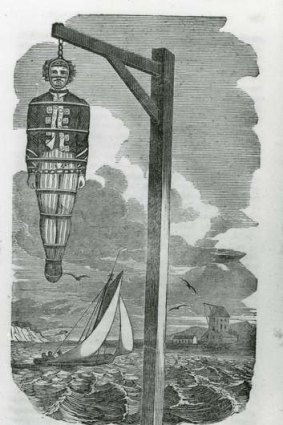
The coves of Ile Sainte-Marie.
Doug Hendrie hides the rum and explores the final resting place of many a pirate of the seven seas.
It's raining heavily as Camara poles our pirogue across the still, shallow waters of the Bay of Rogues towards the world's only pirate cemetery. My wife and I hold umbrellas high to fend off the deluge. Ile Sainte-Marie, a sleepy 60-kilometre splinter off Madagascar's north-east, is ground zero for cyclones sweeping in from the Indian Ocean, and the season is imminent. Villagers wade through the silted bay with nets. When pirates came here more than 300 years ago, the Bay of Rogues was deep and still, secure from cyclones. Better - there was a tiny islet, the Ile aux Forbans, where the pirates could moor their small ships in plain sight. Passing traders would see these tadpoles and not spare them a thought. But lurking behind the island were larger pirate ships, dreaded by sailors, built for speed and for war. The traders - heavy with loot - were easy prey.
Piracy is inextricably linked with the Caribbean, but Madagascar was equally well placed during the colonial era. Traders coming from Europe were relieved of their gold and silver, and those bound for Europe lost their cloth, silk, spices and jewels from the colonies. The spoils were sold to Indian Ocean merchants willing to act as fences for the stolen goods. An even easier target was the pilgrim fleet shuttling rich Muslims from Surat in India to the Arabian Peninsula. Before long, Ile Sainte-Marie lured many of the world's most famous pirates, such as the Scotsman William Kidd, the French pirate Olivier Levasseur, nicknamed "the Buzzard" for his ruthlessness, and Englishman Thomas Tew, a privateer-turned-pirate who pioneered the "Pirate Round", a route from the western Atlantic around southern Africa up to Yemen, shadowing ships of the East India Company.

Children in the main island town of Ambodifotatra.Credit: Getty Images
These days, piracy has moved north, to the lawless fringes of Somalia, and Europe's pirates, privateers and corsairs have left only graves, high on a hill on the edge of the bay, overlooking their old domain.
Our guide leaps from the pirogue and hauls us ashore between mangrove roots. He wears a blingy gold chain and sunglasses a rapper might wear. We pass upwards through the lands of a small village: rice paddies, papaya, cassava, chickens and children chasing each other.
The Malagasy are not African. Most are of Austronesian stock, descended from voyagers from modern day Indonesia. The rain abruptly stops as we reach the summit. The view is stunning. I can see a small island perched at the mouth of the bay, which was once home to the island's royalty. When the pirates came, they traded with the royal family, using their wealth to buy slaves or crew. The queen herself became a pirate bride. As a dowry, her father ceded the pirates the promontory where the cemetery lies.

Rogue's gallery: The pirate cemetery at Ile Sainte-Marie.
Two more steps and we're into the graveyard of the pirates. It's an airy, open place, dotted with the traveller's palm, Madagascar's national symbol. The graves are rough-carved granite, and many have half-sunk into the soft earth. Many bear names in French, but English is equally common. Ile Sainte-Marie's pirates were a rough fraternity of nations. Mulattos, ethnic Malagasy, French, English and Dutch sailed these waters.
"There were pirates, and there were corsairs," Camara says. What's the difference? "Pirates raided for their own interests, and corsairs for the national interest," he says, grinning. The demarcation was never clear-cut. Many pirates began as corsairs before figuring out it was easier to keep the loot.
Camara leads us to a large tumbledown edifice of rock. This, he says, is a tribute to William Kidd, the privateer forced by the British to hunt other pirates. Kidd had little success. His crew of hardened rogues deserted in Madagascar, and Kidd was eventually lured into a legal trap in America. Sent home to face trial, Kidd protested his innocence vigorously. It was no use. In death, Kidd became far more famous as rumour spread that he had gone to his grave without revealing the whereabouts of a cache of treasure.

A pirate's grave.Credit: Doug Hendrie
Many of the smaller graves bear the same date: 1875, the sunset of piracy. Malaria ripped through the pirate ships that year, and many bodies were planted atop this hill. Atop a nearby grave is a small stone church, a replica of the one visible across the bay and the first built in Madagascar under French colonial rule. A Christian cross jutting out of a rusty cannonball adorns the grave of a nameless pirate. This was how the pirates lived: by Christ and the cannon.
Camara leads us onwards through the cemetery. He's looking for something. His brow clears and he gestures. It's a real skull-and-crossbones engraved on a granite slab. Nearby is a mass grave for unknown pirates, those who died in battle with desperate sailors. "Their bodies were sliced by epee and they put the parts in here," Camara says. He leaps nimbly across the ground with an umbrella in hand, mimicking the deadly dance of shipboard combat.
Camara leads us back to the pirogue, and poles us across the passage to Ile aux Forbans, the pirate island. Little is left of their presence, for pirates slept on their ships and did not build to last. All that remains is a breakwater built to shield their smaller ships at harbour. As we ascend, Camara points out a large hole. Treasure hunting teams have probed this island again and again. Had Kidd hidden his cache here? "Did they find anything?" I ask. Camara shrugs.

Scottish sailor William Kidd was executed for piracy in 1701.Credit: Getty Images
"They said no. I think they did. Would you tell the truth if you found treasure?"
As our pirogue slowly rocks us back across the bay, Camara tells us that the pirates are not entirely gone. Three pirate ships lie deep in the silt of the bay beneath us, saved from rot by the mud. And in the island's main town of Ambodifotatra, there is a restaurant named Kidd, where the descendants of the famed pirate now use his notoriety to entice French tourists, wallets bulging, into their domain.
FAST FACTS
Getting there
South African Airways has a fare to Antananarivo, Madagascar, from Sydney and Melbourne for about $2440 return, including taxes. Fly to Perth (about 4hr with Qantas), then to Johannesburg (11hr 30min) and then to Antananarivo (3hr 10min); see flysaa.com. Air Madagascar flies from Antananarivo to Sainte-Marie for about $215 return, including taxes. Flight time is 2hr including transit time in Tamatave; see airmadagascar.com.
Pirogues to the pirate cemetery (about $10 a person) can be found just south of the main town, Ambodifotatra.
Staying there
Beachfront bungalows at the secluded Hotel la Crique are priced at $25 a night for a no-frills double or $47 a night for hot water and a bathroom. See lacrique-saintemarie.com.
Sign up for the Traveller Deals newsletter
Get exclusive travel deals delivered straight to your inbox. Sign up now.